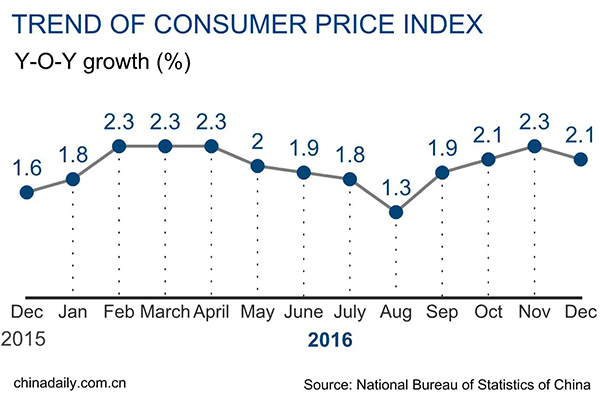China consumer prices up 2% in 2016

BEIJING - China's consumer inflation reported faster growth last year, the National Bureau of Statistics (NBS) said Tuesday, as a price rebound in commodities gradually drove up prices.
The consumer price index (CPI), a main gauge of inflation, rose 2 percent in 2016 -- up from 1.4 percent in 2015 -- the same rate as 2014, according to an NBS statement.
The figure was below the government's 3-percent target set for the whole year.
In December, the CPI increased 2.1 percent from a year ago, slightly down from November's 2.3-percent rise.
NBS senior statistician Sheng Guoqing attributed December's slowdown to a high base in the same period of 2015 and weak price increases in vegetables and fruit.
The NBS also releases figures on China's industrial inflation. The producer price index (PPI), which measures costs for goods at the factory gate, rose 5.5 percent year-on-year in December, the highest since September 2011.
PPI for the whole of 2016 dropped 1.4 percent, up from a 5.2-percent drop in 2015.
Related Story:
China expected to be listed among high-income countries by 2022 from people.cn
Reform will boost the growth potential of China's economy, and China is expected to achieve GDP per capita of $12,600 in 2022, making it a high-income country, said Cai Fang, deputy director of the Chinese Academy of Social Science, Shanghai Securities News reported.
Cai made his remarks at a Dec 5 economics forum in Shanghai. He predicted that China's GDP growth rate would be between 6.2 and 6.7 percent during the 13th Five-Year Plan period. Zhu Baoliang, chief economist at the Economic Forecast Department of China's State Information Center, as well as Li Xunlei, a member of the Shanghai Finance Institute's Academic Committee, consider the GDP growth rate in 2016 to be 6.7 percent. The rate is projected to be 6.3 percent in 2017.
According to Zhu, China's economy has not yet reached its nadir; the second lowest level will emerge in 2018. Li pointed out that downward pressure will also be present in 2017.
China's economy is on an L-shaped trajectory in both the short term and long term, said Cai. The economic growth rate is declining due to a disappearance of demographic dividends. While the growth will not see a V-shaped rebound, reform can still improve it.
According to Cai, the long-term L-shaped trajectory is created by long-term reform dividends. For example, household registration system reform can improve the labor participation rate of non-agricultural industries, as well as the productivity rate of the supply side, enlarging consumption from the demand side.
Zhu pointed out that China's economic growth should focus on supply-side structural reform, to further reduce excess capacity, strengthen market means and risk prevention, and promote reforms in administrative and state-owned enterprises, including those related to finance, taxation, land and social security.























